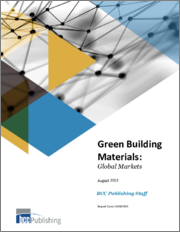
|
시장보고서
상품코드
1308027
세계의 친환경 건축자재 시장Green Building Materials: Global Markets |
||||||
세계의 친환경 건축자재 시장 규모는 2023년 1,841억 달러에서 예측 기간 중 13.6%의 CAGR로 성장을 지속하여 2028년에는 3,477억 달러 규모로 성장할 것으로 예측됩니다.
아메리카는 2023년 909억 달러에서 12.0%의 CAGR로 성장을 지속하여 2028년에는 1,601억 달러 규모로 성장할 것으로 예측됩니다. 또한 아시아태평양은 2023년 508억 달러에서 16.1%의 CAGR로 성장을 지속하여 2028년에는 1,075억 달러 규모로 성장할 것으로 예측됩니다.
세계의 친환경 건축자재(Green Building Materials) 시장을 조사했으며, 시장 개요, 시장 영향요인 및 시장 기회 분석, 시장 규모 추이와 예측, 각종 구분, 지역별 상세 분석, 신기술과 개발 동향, ESG 사례 연구, 경쟁 구도, 주요 기업 개요 등을 정리했습니다.
보고서에 포함된 내용 :
- 세계의 친환경 건축자재 시장 개요와 최신 분석
- 매출 데이터 추산/예측/CAGR
- 현재 및 향후 수요에 영향을 주는 신기술 동향, 기회, 갭 하이라이트와 시장 발전에 기여하는 지역 및 국가 특정
- 시장 규모 추산·매출 예측·시장 점유율 : 건물 유형 및 용도, 지역별
- 주요 시장 역학, 기술 도입, 업계 규제, 최신 전개, 거시경제 변수의 영향
- ESG 관련 사례 연구, ESG 지속가능성을 향한 단계, 기업의 ESG 실천, 건설 부문에서의 ESG 도입 기회와 과제
- 주요 기업이 채택하는 주요 성장 전략, 최근 시장 전개, 전략적 제휴, 경쟁 벤치마킹
- 주요 이해관계자 특정, 최근 동향, 부문별 매출에 근거한 경쟁 구도 분석
- 주요 기업 개요 : Alumasc, Heidelberg Materials, Interface, James Hardie, Kingspan Group, Saint-Gobain
Highlights:
The global market for green building materials is estimated to increase from $184.1 billion in 2023 to reach $347.7 billion by 2028, at a compound annual growth rate (CAGR) of 13.6% from 2023 through 2028.
American green building materials market is estimated to increase from $90.9 billion in 2023 to reach $160.1 billion by 2028, at a CAGR of 12.0% from 2023 through 2028.
Asia-Pacific green building materials market is estimated to increase from $50.8 billion in 2023 to reach $107.5 billion by 2028, at a CAGR of 16.1% from 2023 through 2028.
Report Scope:
This report analyzes the investment opportunities in four regions: the Americas, Europe, the Middle East and Africa (MEA), and the Asia-Pacific (APAC). Regional forecasts are broken down by building type (i.e., commercial, residential, institutional and infrastructure) and by application (i.e., framing, insulation, roofing, exterior siding, and interior finishes). Economic, environmental, regulatory, and technological factors influencing demand are also discussed.
The report will provide insights into the current market scenario, its growth potential, and the competitive landscape for green building materials. The report will also discuss emerging technologies.
Report Includes:
- 25 data tables and 30 additional tables
- An overview and up-to-date analysis of the global markets for green building materials
- Analyses of the global market trends, with historic market revenue data (sales figures) for 2022, estimates for 2023, and projections of compound annual growth rates (CAGRs) through 2028
- Highlights of emerging technology trends, opportunities and gaps estimating current and future demand for green building materials, and identification of the regions and countries involved in market developments
- Estimation of the actual market size and revenue forecast for global green building materials market, and corresponding market share analysis based on the building type, application, and region
- In-depth information (facts and figures) concerning major market dynamics, technology adaptations, industry regulations, latest developments, and the impact of macroeconomic variables on the green building materials market
- Discussion of ESG-related case studies and a brief general overview of the steps taken towards the ESG sustainability, ESG practices by companies, and the opportunities and challenges in implementing ESG in the building sector
- A look at the major growth strategies adopted by leading players operating in the green building materials market, recent developments, strategic alliances, and competitive benchmarking
- Identification of the major stakeholders and analysis of the competitive landscape based on recent developments and segmental revenues
- Descriptive company profiles of the leading global players, including Alumasc, Heidelberg Materials, Interface, James Hardie, Kingspan Group, and Saint-Gobain
Summary:
The total Leadership in Energy and Environmental Design (LEED)-certified building area in 2022 was approximately REDACTED billion sq. ft. This was only REDACTED% of the entire building area, which was REDACTED billion sq. ft. Therefore, green buildings currently comprise a small share of the global construction market, but the investment opportunities in the green building sector are enormous.
BCC Research estimates that the global market for green building materials will increase from $REDACTED billion in 2023 to $REDACTED billion in 2028, representing a REDACTED% CAGR.
The Americas (including Latin American countries) accounted for REDACTED% of all market revenue in 2022, followed by Asia-Pacific with REDACTED%. With a CAGR of REDACTED% over the forecast period, Asia-Pacific will be the fastest-growing region, due to population growth in countries like India, leading to a housing boom. Europe was the next largest market for green building materials in 2022, while the Middle East and African countries represented just REDACTED% of the market.
The residential sector will dominate the market in emerging countries due to increasing population growth and rapid urbanization. The commercial sector will dominate in developed regions such as the U.S. and Europe. Insulation will be the most prominent application sector, especially in the Americas and the Europe.



















